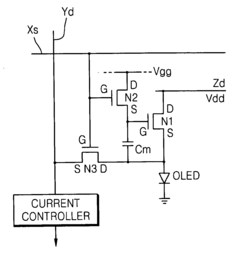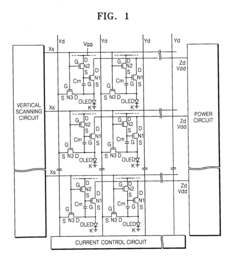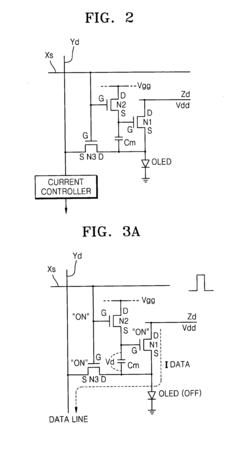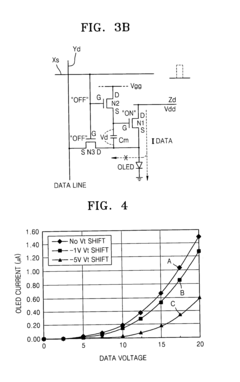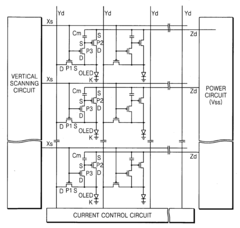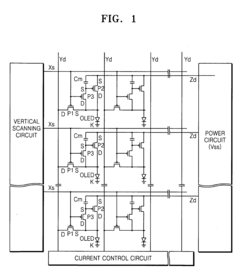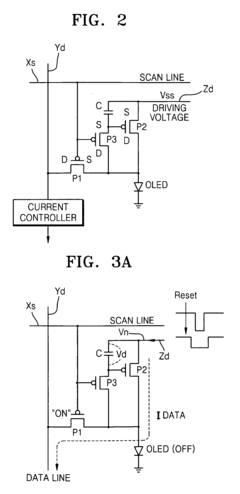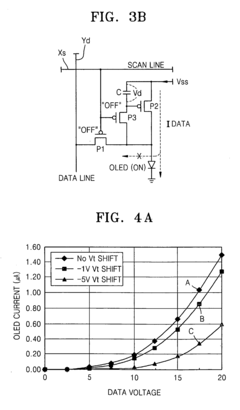Realizing 3D display potential with AMOLED advancements.
JUL 17, 20258 MIN READ
Generate Your Research Report Instantly with AI Agent
Patsnap Eureka helps you evaluate technical feasibility & market potential.
3D AMOLED Evolution
The evolution of 3D AMOLED technology represents a significant milestone in display innovation, marking a paradigm shift in how we perceive and interact with visual content. This journey began with the introduction of basic OLED displays, which offered improved color reproduction and contrast ratios compared to traditional LCD screens. As the technology matured, manufacturers began exploring ways to incorporate depth perception into these displays, leading to the development of early 3D OLED prototypes.
The initial attempts at 3D AMOLED displays relied on passive 3D technology, which required viewers to wear specialized glasses. While this approach provided a basic 3D experience, it was limited in terms of user comfort and practicality. The next phase saw the introduction of active 3D technology, which utilized high-refresh-rate displays and shutter glasses to create a more immersive 3D effect. However, the need for external accessories remained a significant drawback.
A major breakthrough came with the development of autostereoscopic 3D displays, which eliminated the need for glasses altogether. These displays used lenticular lenses or parallax barriers to direct different images to each eye, creating a glasses-free 3D effect. Early versions of this technology suffered from limited viewing angles and reduced resolution, but continuous refinements have led to significant improvements in both areas.
The integration of eye-tracking technology marked another crucial step in the evolution of 3D AMOLED displays. By dynamically adjusting the 3D image based on the viewer's position, these displays could maintain the 3D effect over a wider range of viewing angles. This advancement greatly enhanced the user experience and expanded the potential applications of 3D displays beyond entertainment to fields such as medical imaging and industrial design.
Recent years have seen a focus on increasing the resolution and pixel density of 3D AMOLED displays. The development of 4K and even 8K 3D panels has resulted in unprecedented levels of detail and realism in 3D content. Simultaneously, advancements in AMOLED technology have led to thinner, more flexible displays, opening up new possibilities for curved and foldable 3D screens.
The latest frontier in 3D AMOLED evolution is the exploration of light field displays. These advanced systems aim to recreate the full light field of a scene, allowing for multiple viewpoints and potentially eliminating the vergence-accommodation conflict that can cause discomfort in traditional 3D displays. While still in the early stages of development, light field technology holds the promise of delivering the most natural and immersive 3D viewing experience to date.
The initial attempts at 3D AMOLED displays relied on passive 3D technology, which required viewers to wear specialized glasses. While this approach provided a basic 3D experience, it was limited in terms of user comfort and practicality. The next phase saw the introduction of active 3D technology, which utilized high-refresh-rate displays and shutter glasses to create a more immersive 3D effect. However, the need for external accessories remained a significant drawback.
A major breakthrough came with the development of autostereoscopic 3D displays, which eliminated the need for glasses altogether. These displays used lenticular lenses or parallax barriers to direct different images to each eye, creating a glasses-free 3D effect. Early versions of this technology suffered from limited viewing angles and reduced resolution, but continuous refinements have led to significant improvements in both areas.
The integration of eye-tracking technology marked another crucial step in the evolution of 3D AMOLED displays. By dynamically adjusting the 3D image based on the viewer's position, these displays could maintain the 3D effect over a wider range of viewing angles. This advancement greatly enhanced the user experience and expanded the potential applications of 3D displays beyond entertainment to fields such as medical imaging and industrial design.
Recent years have seen a focus on increasing the resolution and pixel density of 3D AMOLED displays. The development of 4K and even 8K 3D panels has resulted in unprecedented levels of detail and realism in 3D content. Simultaneously, advancements in AMOLED technology have led to thinner, more flexible displays, opening up new possibilities for curved and foldable 3D screens.
The latest frontier in 3D AMOLED evolution is the exploration of light field displays. These advanced systems aim to recreate the full light field of a scene, allowing for multiple viewpoints and potentially eliminating the vergence-accommodation conflict that can cause discomfort in traditional 3D displays. While still in the early stages of development, light field technology holds the promise of delivering the most natural and immersive 3D viewing experience to date.
3D Display Market Trends
The 3D display market has been experiencing significant growth and transformation in recent years, driven by advancements in display technologies, particularly in the realm of AMOLED (Active-Matrix Organic Light-Emitting Diode) displays. This market segment is poised for substantial expansion as consumers and industries alike seek more immersive and interactive visual experiences.
The demand for 3D displays is rapidly increasing across various sectors, including entertainment, gaming, healthcare, education, and industrial applications. In the entertainment industry, 3D televisions and cinema screens continue to evolve, offering viewers enhanced depth perception and a more engaging viewing experience. The gaming sector has been a major driver of 3D display adoption, with gamers seeking more realistic and immersive gameplay environments.
Healthcare is another key area where 3D displays are gaining traction. Medical imaging technologies, such as 3D ultrasound and 3D-rendered CT scans, are revolutionizing diagnostics and surgical planning. These advancements allow for more accurate visualization of anatomical structures, leading to improved patient outcomes and more efficient medical procedures.
The education sector is also embracing 3D display technology, with interactive learning environments and virtual classrooms becoming increasingly popular. These tools enable students to visualize complex concepts in three dimensions, enhancing comprehension and retention of information.
In the industrial realm, 3D displays are finding applications in design and prototyping, allowing engineers and designers to visualize and manipulate 3D models with greater precision. This technology is particularly valuable in industries such as automotive, aerospace, and architecture, where accurate spatial representation is crucial.
The integration of AMOLED technology with 3D displays is a key trend shaping the market. AMOLED displays offer several advantages over traditional LCD screens, including higher contrast ratios, faster response times, and better color reproduction. These characteristics make AMOLED displays particularly well-suited for 3D applications, as they can provide the high-quality visuals necessary for convincing depth perception.
As AMOLED technology continues to advance, we can expect to see more sophisticated 3D display solutions entering the market. These may include glasses-free 3D displays with improved viewing angles and resolution, as well as flexible and foldable 3D screens that can adapt to various form factors and use cases.
The global market for 3D displays is projected to grow substantially in the coming years, with Asia-Pacific region expected to be a major contributor to this growth. Factors such as increasing disposable income, rapid technological adoption, and a growing entertainment industry in countries like China and South Korea are driving this regional trend.
The demand for 3D displays is rapidly increasing across various sectors, including entertainment, gaming, healthcare, education, and industrial applications. In the entertainment industry, 3D televisions and cinema screens continue to evolve, offering viewers enhanced depth perception and a more engaging viewing experience. The gaming sector has been a major driver of 3D display adoption, with gamers seeking more realistic and immersive gameplay environments.
Healthcare is another key area where 3D displays are gaining traction. Medical imaging technologies, such as 3D ultrasound and 3D-rendered CT scans, are revolutionizing diagnostics and surgical planning. These advancements allow for more accurate visualization of anatomical structures, leading to improved patient outcomes and more efficient medical procedures.
The education sector is also embracing 3D display technology, with interactive learning environments and virtual classrooms becoming increasingly popular. These tools enable students to visualize complex concepts in three dimensions, enhancing comprehension and retention of information.
In the industrial realm, 3D displays are finding applications in design and prototyping, allowing engineers and designers to visualize and manipulate 3D models with greater precision. This technology is particularly valuable in industries such as automotive, aerospace, and architecture, where accurate spatial representation is crucial.
The integration of AMOLED technology with 3D displays is a key trend shaping the market. AMOLED displays offer several advantages over traditional LCD screens, including higher contrast ratios, faster response times, and better color reproduction. These characteristics make AMOLED displays particularly well-suited for 3D applications, as they can provide the high-quality visuals necessary for convincing depth perception.
As AMOLED technology continues to advance, we can expect to see more sophisticated 3D display solutions entering the market. These may include glasses-free 3D displays with improved viewing angles and resolution, as well as flexible and foldable 3D screens that can adapt to various form factors and use cases.
The global market for 3D displays is projected to grow substantially in the coming years, with Asia-Pacific region expected to be a major contributor to this growth. Factors such as increasing disposable income, rapid technological adoption, and a growing entertainment industry in countries like China and South Korea are driving this regional trend.
AMOLED 3D Challenges
The realization of 3D display potential through AMOLED advancements faces several significant challenges. One of the primary obstacles is the need for high pixel density to achieve convincing 3D effects without visible pixelation. Current AMOLED displays, while offering excellent color reproduction and contrast, still struggle to provide the ultra-high resolution required for seamless 3D imagery, especially when viewed at close distances.
Another critical challenge lies in the power consumption of 3D AMOLED displays. The increased computational requirements for rendering 3D content, coupled with the need for higher brightness to compensate for the light loss in 3D modes, can lead to substantial energy drain. This poses a significant hurdle for mobile devices where battery life is a crucial factor.
The issue of viewing angles presents another complex problem. While AMOLED displays generally offer wide viewing angles, maintaining the 3D effect across different viewing positions remains challenging. This is particularly problematic for multi-viewer scenarios, where the 3D effect needs to be preserved for multiple users simultaneously.
Heat dissipation is an often-overlooked challenge in AMOLED 3D displays. The increased power consumption and computational load can lead to higher operating temperatures, potentially affecting the longevity and performance of the display. Effective thermal management solutions need to be developed to ensure stable long-term operation.
Manufacturing complexities also pose significant challenges. The production of high-resolution AMOLED panels with 3D capabilities requires extremely precise manufacturing processes. Achieving consistent quality across large production runs while maintaining cost-effectiveness is a major hurdle for widespread adoption.
Moreover, the integration of eye-tracking technology, often necessary for optimal 3D viewing experiences, adds another layer of complexity. Ensuring accurate and responsive eye tracking without compromising the sleek design of modern devices is a delicate balance to strike.
Lastly, content creation and compatibility present ongoing challenges. The lack of standardized formats for 3D content creation and display can hinder the widespread adoption of 3D AMOLED technology. Developing user-friendly tools for content creators and ensuring backward compatibility with existing 2D content are crucial steps in overcoming this hurdle.
Another critical challenge lies in the power consumption of 3D AMOLED displays. The increased computational requirements for rendering 3D content, coupled with the need for higher brightness to compensate for the light loss in 3D modes, can lead to substantial energy drain. This poses a significant hurdle for mobile devices where battery life is a crucial factor.
The issue of viewing angles presents another complex problem. While AMOLED displays generally offer wide viewing angles, maintaining the 3D effect across different viewing positions remains challenging. This is particularly problematic for multi-viewer scenarios, where the 3D effect needs to be preserved for multiple users simultaneously.
Heat dissipation is an often-overlooked challenge in AMOLED 3D displays. The increased power consumption and computational load can lead to higher operating temperatures, potentially affecting the longevity and performance of the display. Effective thermal management solutions need to be developed to ensure stable long-term operation.
Manufacturing complexities also pose significant challenges. The production of high-resolution AMOLED panels with 3D capabilities requires extremely precise manufacturing processes. Achieving consistent quality across large production runs while maintaining cost-effectiveness is a major hurdle for widespread adoption.
Moreover, the integration of eye-tracking technology, often necessary for optimal 3D viewing experiences, adds another layer of complexity. Ensuring accurate and responsive eye tracking without compromising the sleek design of modern devices is a delicate balance to strike.
Lastly, content creation and compatibility present ongoing challenges. The lack of standardized formats for 3D content creation and display can hinder the widespread adoption of 3D AMOLED technology. Developing user-friendly tools for content creators and ensuring backward compatibility with existing 2D content are crucial steps in overcoming this hurdle.
Current 3D AMOLED Tech
01 AMOLED display structure for 3D applications
AMOLED displays are being adapted for 3D applications by incorporating specialized pixel structures and driving methods. These designs enable the display to produce stereoscopic images, creating a 3D effect without the need for special glasses. The structure may include additional sub-pixels or modified pixel arrangements to support 3D image rendering.- AMOLED display structure for 3D applications: AMOLED displays are being adapted for 3D applications by incorporating specialized pixel arrangements and driving methods. These structures enable the display to produce stereoscopic images, creating a 3D effect without the need for special glasses. The designs often involve optimizing subpixel layouts and implementing advanced control circuits to manage the 3D image output.
- Touch sensing integration in AMOLED 3D displays: Touch sensing functionality is being integrated into AMOLED 3D displays to enhance user interaction. This integration involves incorporating touch sensors within the display structure, often using in-cell or on-cell touch technologies. The combination of touch sensing and 3D display capabilities in AMOLED panels enables more immersive and interactive user experiences.
- Flexible and foldable AMOLED 3D displays: Development of flexible and foldable AMOLED displays capable of 3D image reproduction is ongoing. These displays utilize advanced materials and manufacturing techniques to create bendable or foldable screens that can still produce high-quality 3D images. The flexibility adds new form factors and use cases for 3D AMOLED displays in various devices.
- Enhanced color and brightness control for 3D AMOLED: Improved color and brightness control mechanisms are being implemented in 3D AMOLED displays. These advancements involve sophisticated pixel driving schemes and color management systems that optimize the display's performance for 3D content. The enhancements aim to provide more vivid and accurate 3D images while maintaining energy efficiency.
- Eye-tracking and viewing angle optimization for 3D AMOLED: Eye-tracking technologies and viewing angle optimization techniques are being incorporated into 3D AMOLED displays. These features help to improve the 3D viewing experience by adjusting the display output based on the viewer's position and gaze direction. This results in more stable and comfortable 3D image perception across different viewing angles and distances.
02 Pixel circuit design for 3D AMOLED displays
Advanced pixel circuit designs are being developed to support 3D functionality in AMOLED displays. These circuits may include additional transistors, capacitors, or other components to enable precise control of each sub-pixel for 3D image generation. The designs focus on improving response time, reducing crosstalk, and enhancing overall 3D image quality.Expand Specific Solutions03 Driving methods for 3D AMOLED displays
Specialized driving methods are being developed to control AMOLED displays for 3D applications. These methods may involve alternating left and right eye images, using time-division multiplexing, or employing other techniques to create the illusion of depth. The driving schemes are designed to minimize flicker, reduce ghosting effects, and improve overall 3D image quality.Expand Specific Solutions04 Integration of touch and 3D functionality in AMOLED displays
Efforts are being made to integrate touch functionality with 3D AMOLED displays. This integration may involve incorporating touch sensors within the display structure or developing new sensing technologies compatible with 3D display operation. The goal is to create interactive 3D AMOLED displays that can respond to user touch inputs while maintaining high-quality 3D visuals.Expand Specific Solutions05 Flexible and foldable 3D AMOLED displays
Research is being conducted on flexible and foldable 3D AMOLED displays. These displays aim to combine the benefits of AMOLED technology, 3D functionality, and flexible form factors. Challenges being addressed include maintaining 3D image quality when the display is bent or folded, and developing suitable materials and manufacturing processes for flexible 3D AMOLED displays.Expand Specific Solutions
Key 3D AMOLED Players
The market for 3D display technology utilizing AMOLED advancements is in a growth phase, with increasing demand and technological progress. The global 3D display market size is projected to expand significantly in the coming years, driven by applications in consumer electronics, automotive, and healthcare sectors. Technologically, AMOLED-based 3D displays are advancing rapidly, with key players like Samsung Electronics, BOE Technology, and LG Electronics leading innovation. These companies are investing heavily in R&D to improve display quality, energy efficiency, and form factors. While the technology is maturing, there's still room for substantial improvements in areas such as resolution, viewing angles, and cost-effectiveness, indicating a dynamic competitive landscape with opportunities for both established players and new entrants.
BOE Technology Group Co., Ltd.
Technical Solution: BOE has made significant strides in AMOLED technology for 3D displays. They have developed a flexible AMOLED display with a resolution of up to 2880x3200 pixels, capable of producing high-quality 3D images[5]. BOE's AMOLED panels incorporate advanced pixel compensation technology, ensuring uniform brightness and color across the display for consistent 3D viewing[6]. They have also introduced a new electrode structure that improves light transmission efficiency by up to 20%, enhancing the overall brightness and energy efficiency of 3D content[7]. Furthermore, BOE has implemented a proprietary color management system that optimizes color reproduction for various 3D viewing angles[8].
Strengths: Large-scale production capabilities, diverse product portfolio, and strong presence in the Chinese market. Weaknesses: Relatively newer to AMOLED technology compared to some competitors, potentially higher defect rates in early production stages.
Samsung Electronics Co., Ltd.
Technical Solution: Samsung has made significant advancements in AMOLED technology for 3D displays. They have developed a novel pixel structure that allows for improved light emission efficiency and reduced power consumption[1]. Their latest AMOLED panels incorporate quantum dot technology, enhancing color accuracy and brightness for more immersive 3D experiences[2]. Samsung has also introduced variable refresh rate technology, which can dynamically adjust from 1Hz to 120Hz, optimizing power usage while maintaining smooth 3D content playback[3]. Additionally, they have implemented advanced touch sensors directly into the OLED panel, reducing overall thickness and improving touch responsiveness for 3D interactions[4].
Strengths: Industry-leading AMOLED technology, high production capacity, and strong R&D capabilities. Weaknesses: Higher production costs compared to traditional LCD technology, potential for screen burn-in with static 3D images.
Core 3D AMOLED Patents
Unit pixels and active matrix organic light emitting diode displays including the same
PatentInactiveUS20090201278A1
Innovation
- The implementation of a current-programmable AMOLED display design using a simpler structure with fewer transistors, including a driving transistor, a programming transistor, and a switching transistor, where a memory capacitor is connected in parallel between the gate and one terminal of the driving transistor, and a current controller determines the current flowing through the transistors to maintain uniform brightness despite threshold voltage shifts.
Active matrix organic light emitting diode display
PatentInactiveUS20090201234A1
Innovation
- The AMOLED display employs a 3-transistor-1-capacitor (3T-1C) structure with p-channel transistors, including a driving transistor, a switching transistor, and a programming transistor, along with a memory capacitor and a current controller, to control current flow and maintain uniform brightness by compensating for threshold voltage shifts, allowing for simpler pixel design and improved reliability.
3D Content Ecosystem
The 3D content ecosystem plays a crucial role in realizing the full potential of AMOLED-based 3D displays. As these advanced displays become more prevalent, the demand for high-quality 3D content is expected to surge across various industries and applications.
One of the primary drivers of the 3D content ecosystem is the entertainment industry. Film studios and game developers are increasingly investing in 3D content creation to provide immersive experiences for viewers and players. This trend is likely to accelerate with the widespread adoption of AMOLED 3D displays, as they offer superior color reproduction and contrast ratios compared to traditional LCD screens.
In the field of education and training, 3D content is becoming an invaluable tool for enhancing learning experiences. Interactive 3D models and simulations can help students better understand complex concepts in subjects such as anatomy, chemistry, and engineering. As AMOLED 3D displays become more accessible, educational institutions may increasingly incorporate 3D content into their curricula.
The architecture and design industries are also significant contributors to the 3D content ecosystem. With AMOLED 3D displays, architects and designers can create and present highly detailed and realistic 3D models of buildings and products. This capability not only improves the design process but also enhances client communication and decision-making.
E-commerce is another sector that stands to benefit from the growth of the 3D content ecosystem. Online retailers can leverage 3D product visualizations to provide customers with a more engaging and informative shopping experience. As AMOLED 3D displays become more common in consumer devices, this trend is likely to accelerate, potentially revolutionizing the way people shop online.
The medical field is also embracing 3D content, particularly in areas such as diagnostic imaging and surgical planning. AMOLED 3D displays can provide healthcare professionals with highly detailed and accurate visualizations of patient data, improving diagnosis and treatment outcomes.
To support the growing demand for 3D content, a robust ecosystem of tools and platforms is emerging. This includes advanced 3D modeling software, rendering engines, and content management systems specifically designed for 3D assets. As AMOLED 3D display technology evolves, these tools are likely to become more sophisticated and user-friendly, lowering the barriers to entry for 3D content creation.
The development of standards and formats for 3D content is another critical aspect of the ecosystem. As the industry matures, there is a growing need for interoperability and consistency across different platforms and devices. This standardization effort will be essential in ensuring that 3D content can be easily created, distributed, and displayed on AMOLED 3D screens across various applications and industries.
One of the primary drivers of the 3D content ecosystem is the entertainment industry. Film studios and game developers are increasingly investing in 3D content creation to provide immersive experiences for viewers and players. This trend is likely to accelerate with the widespread adoption of AMOLED 3D displays, as they offer superior color reproduction and contrast ratios compared to traditional LCD screens.
In the field of education and training, 3D content is becoming an invaluable tool for enhancing learning experiences. Interactive 3D models and simulations can help students better understand complex concepts in subjects such as anatomy, chemistry, and engineering. As AMOLED 3D displays become more accessible, educational institutions may increasingly incorporate 3D content into their curricula.
The architecture and design industries are also significant contributors to the 3D content ecosystem. With AMOLED 3D displays, architects and designers can create and present highly detailed and realistic 3D models of buildings and products. This capability not only improves the design process but also enhances client communication and decision-making.
E-commerce is another sector that stands to benefit from the growth of the 3D content ecosystem. Online retailers can leverage 3D product visualizations to provide customers with a more engaging and informative shopping experience. As AMOLED 3D displays become more common in consumer devices, this trend is likely to accelerate, potentially revolutionizing the way people shop online.
The medical field is also embracing 3D content, particularly in areas such as diagnostic imaging and surgical planning. AMOLED 3D displays can provide healthcare professionals with highly detailed and accurate visualizations of patient data, improving diagnosis and treatment outcomes.
To support the growing demand for 3D content, a robust ecosystem of tools and platforms is emerging. This includes advanced 3D modeling software, rendering engines, and content management systems specifically designed for 3D assets. As AMOLED 3D display technology evolves, these tools are likely to become more sophisticated and user-friendly, lowering the barriers to entry for 3D content creation.
The development of standards and formats for 3D content is another critical aspect of the ecosystem. As the industry matures, there is a growing need for interoperability and consistency across different platforms and devices. This standardization effort will be essential in ensuring that 3D content can be easily created, distributed, and displayed on AMOLED 3D screens across various applications and industries.
User Experience Impact
The integration of 3D display capabilities with AMOLED technology has the potential to revolutionize user experience across various applications. This advancement promises to deliver more immersive and interactive visual experiences, enhancing user engagement and satisfaction.
In the realm of entertainment, 3D AMOLED displays could transform how users consume media. Movies, video games, and virtual reality experiences would benefit from enhanced depth perception and more realistic visual representations. This could lead to increased user immersion and emotional connection with content, potentially driving higher engagement rates and longer viewing sessions.
For productivity applications, 3D AMOLED displays could improve data visualization and manipulation. Complex 3D models in fields such as architecture, engineering, and scientific research could be more easily understood and manipulated, potentially accelerating decision-making processes and improving overall efficiency.
In the e-commerce sector, 3D product visualization could significantly enhance the online shopping experience. Customers would be able to examine products from multiple angles with a sense of depth, potentially reducing return rates and increasing customer satisfaction.
The impact on mobile devices could be particularly significant. Smartphones and tablets equipped with 3D AMOLED displays could offer new ways of interacting with apps and content, potentially leading to the development of novel user interfaces and interaction paradigms.
However, the integration of 3D capabilities with AMOLED technology also presents challenges that could affect user experience. Issues such as eye strain, motion sickness, and the need for specialized viewing angles or equipment might limit widespread adoption or prolonged use.
Furthermore, the success of 3D AMOLED displays in enhancing user experience will largely depend on the availability of compatible content and applications. Without a robust ecosystem of 3D-optimized software and media, the technology's impact on user experience may be limited.
In conclusion, while 3D AMOLED displays have the potential to significantly enhance user experience across multiple domains, their success will depend on overcoming technical challenges and fostering a supportive content ecosystem. As the technology matures, we can expect to see innovative applications that leverage these capabilities to create more engaging and immersive user experiences.
In the realm of entertainment, 3D AMOLED displays could transform how users consume media. Movies, video games, and virtual reality experiences would benefit from enhanced depth perception and more realistic visual representations. This could lead to increased user immersion and emotional connection with content, potentially driving higher engagement rates and longer viewing sessions.
For productivity applications, 3D AMOLED displays could improve data visualization and manipulation. Complex 3D models in fields such as architecture, engineering, and scientific research could be more easily understood and manipulated, potentially accelerating decision-making processes and improving overall efficiency.
In the e-commerce sector, 3D product visualization could significantly enhance the online shopping experience. Customers would be able to examine products from multiple angles with a sense of depth, potentially reducing return rates and increasing customer satisfaction.
The impact on mobile devices could be particularly significant. Smartphones and tablets equipped with 3D AMOLED displays could offer new ways of interacting with apps and content, potentially leading to the development of novel user interfaces and interaction paradigms.
However, the integration of 3D capabilities with AMOLED technology also presents challenges that could affect user experience. Issues such as eye strain, motion sickness, and the need for specialized viewing angles or equipment might limit widespread adoption or prolonged use.
Furthermore, the success of 3D AMOLED displays in enhancing user experience will largely depend on the availability of compatible content and applications. Without a robust ecosystem of 3D-optimized software and media, the technology's impact on user experience may be limited.
In conclusion, while 3D AMOLED displays have the potential to significantly enhance user experience across multiple domains, their success will depend on overcoming technical challenges and fostering a supportive content ecosystem. As the technology matures, we can expect to see innovative applications that leverage these capabilities to create more engaging and immersive user experiences.
Unlock deeper insights with Patsnap Eureka Quick Research — get a full tech report to explore trends and direct your research. Try now!
Generate Your Research Report Instantly with AI Agent
Supercharge your innovation with Patsnap Eureka AI Agent Platform!
